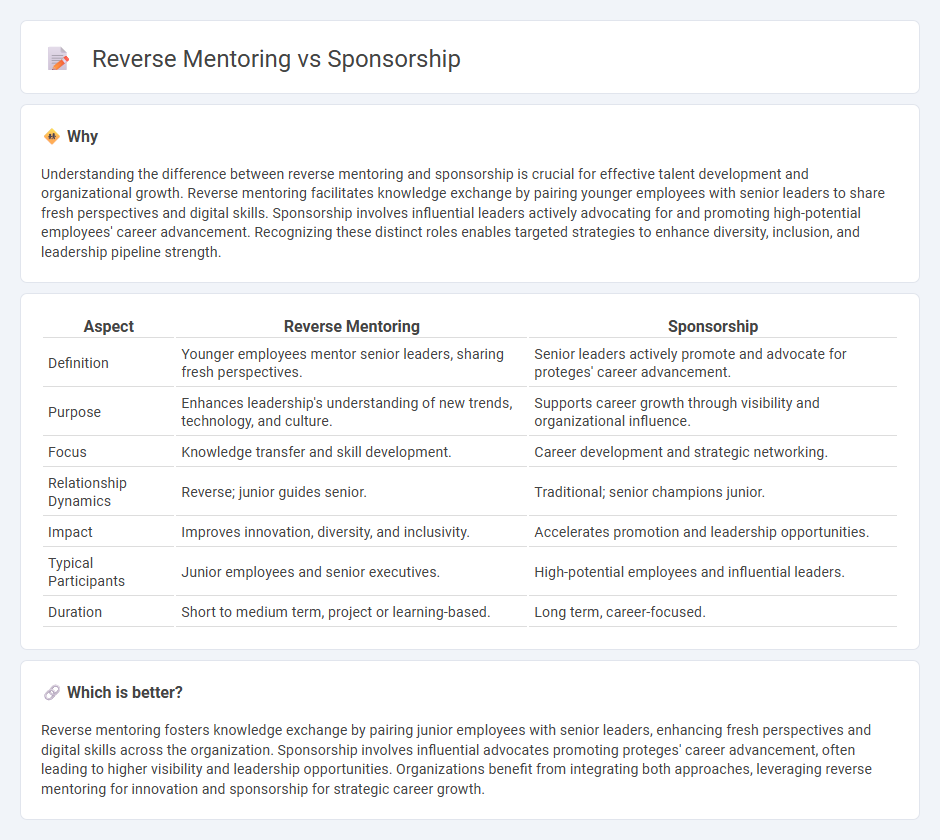
Reverse mentoring fosters knowledge exchange by connecting junior employees' fresh perspectives with senior leaders' experience, enhancing organizational agility and innovation. Sponsorship involves senior leaders actively advocating for proteges' career advancement, providing access to strategic opportunities and networks. Explore deeper to understand how reverse mentoring and sponsorship uniquely impact career development and organizational culture.
Why it is important
Understanding the difference between reverse mentoring and sponsorship is crucial for effective talent development and organizational growth. Reverse mentoring facilitates knowledge exchange by pairing younger employees with senior leaders to share fresh perspectives and digital skills. Sponsorship involves influential leaders actively advocating for and promoting high-potential employees' career advancement. Recognizing these distinct roles enables targeted strategies to enhance diversity, inclusion, and leadership pipeline strength.
Comparison Table
| Aspect | Reverse Mentoring | Sponsorship |
|---|---|---|
| Definition | Younger employees mentor senior leaders, sharing fresh perspectives. | Senior leaders actively promote and advocate for proteges' career advancement. |
| Purpose | Enhances leadership's understanding of new trends, technology, and culture. | Supports career growth through visibility and organizational influence. |
| Focus | Knowledge transfer and skill development. | Career development and strategic networking. |
| Relationship Dynamics | Reverse; junior guides senior. | Traditional; senior champions junior. |
| Impact | Improves innovation, diversity, and inclusivity. | Accelerates promotion and leadership opportunities. |
| Typical Participants | Junior employees and senior executives. | High-potential employees and influential leaders. |
| Duration | Short to medium term, project or learning-based. | Long term, career-focused. |
Which is better?
Reverse mentoring fosters knowledge exchange by pairing junior employees with senior leaders, enhancing fresh perspectives and digital skills across the organization. Sponsorship involves influential advocates promoting proteges' career advancement, often leading to higher visibility and leadership opportunities. Organizations benefit from integrating both approaches, leveraging reverse mentoring for innovation and sponsorship for strategic career growth.
Connection
Reverse mentoring fosters knowledge exchange between senior leaders and younger employees, enhancing leadership development and organizational agility. Sponsorship supports this dynamic by empowering emerging talent with advocates who provide visibility and career advancement opportunities. Integrating reverse mentoring with sponsorship strengthens talent pipelines and drives inclusive leadership growth within companies.
Key Terms
Power Dynamics
Sponsorship involves a senior individual advocating for a junior person, leveraging their influence to open doors and create opportunities, while reverse mentoring flips traditional roles by enabling younger employees to share fresh perspectives and digital expertise with senior leaders. Power dynamics in sponsorship often reinforce hierarchical structures, whereas reverse mentoring promotes more egalitarian and reciprocal relationships. Explore deeper insights into how these models reshape workplace interactions and career development.
Knowledge Transfer
Sponsorship involves a senior leader advocating for and actively promoting the career advancement of a protege, often sharing critical industry insights and organizational knowledge. Reverse mentoring facilitates knowledge transfer by enabling younger employees to share fresh perspectives, digital skills, and emerging trends with senior leaders, fostering mutual learning across generational divides. Explore how combining sponsorship and reverse mentoring can enhance knowledge transfer and drive innovation within your organization.
Career Development
Sponsorship involves influential advocates who actively promote an individual's career advancement by providing opportunities and visibility within an organization. Reverse mentoring flips traditional roles, enabling younger employees to share fresh perspectives and digital expertise with senior leaders, fostering mutual growth and innovation. Explore how integrating both approaches can accelerate your career development strategies.
Source and External Links
How to Get Sponsorships for Your Business - This article discusses how small businesses can secure sponsorships by targeting corporations that align with their customer base and marketing needs.
What is Sponsorship? - This piece explores sponsorship as a marketing tool used by companies to achieve their objectives through various types like sports, cultural, and educational sponsorships.
How to Unlock Corporate Sponsorships - This guide provides strategies for nonprofits to secure corporate sponsorships, including forming committees and defining their value proposition for potential sponsors.
 dowidth.com
dowidth.com